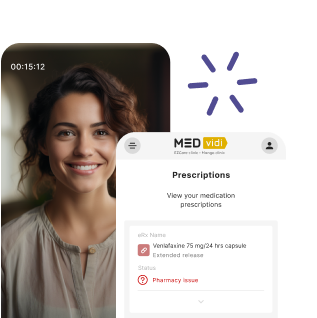Their inclusion does not guarantee they will be prescribed to any individual, as treatment decisions are ultimately at the discretion of healthcare providers. Healthcare providers may prescribe other medications or recommend non-pharmacological treatment based on the patient’s unique health circumstances and needs. Read more
Xanax has a
Highlights
- Usually, a doctor prescribes Xanax (alprazolam) as a second-line treatment for anxiety disorders such as generalized anxiety disorder and panic disorder; sometimes it is used off-label for other mental health conditions.
- Taking alprazolam can cause common side effects, such as tiredness, dizziness, forgetfulness, and difficulty concentrating.
- Xanax interacts with many prescribed and over-the-counter medications, including herbal supplements, and food; therefore, it is essential to inform your doctor about all treatments you are taking and to read the patient package insert.
To understand which medications you cannot take with Xanax (alprazolam), you need to know why they might cause a problem. Interactions can be broken down into two types:
- Medications that interfere with the breakdown of alprazolam.
- Other CNS depressants can intensify alprazolam’s side effects.
There is one class of drugs, opioids, that can have both of these interactions and be life-threatening if used with alprazolam.
Let’s start with the basics of alprazolam, how it’s metabolized, and then move on to the medications you should avoid and why.
Personalized care for anxiety

A Brief Overview of Alprazolam
Xanax, also known as alprazolam, is a benzodiazepine medication that has a relaxing effect on the central nervous system (CNS), which includes the brain and spinal cord. It causes CNS depression by increasing the activity of GABA (gamma aminobutyric acid), the
The Food and Drug Administration (FDA) has
Alprazolam tablets come in various forms that stay in your system for different lengths of time:
Reasons Behind Alprazolam Drug Interactions
Alprazolam is broken down (metabolized) in the liver by an enzyme, CYP3A4. Medications and substances called CYP3A4 inhibitors or inducers
Another way medication can cause problems is by having similar side effects to alprazolam. As mentioned, Xanax calms the brain and nerves, so can cause both mental and physical adverse effects. These reactions can be worse or life-threatening when using other medication that also relaxes the CNS (CNS depressants).
Firstly, let’s take a look at some of these interactions and medications to avoid. Later, we’ll discuss the side effects, so that you know what to look out for.

Alprazolam Interactions With Prescription Medications
Below in the table is a quick reference to some medications that could be problematic if used in combination with alprazolam. Importantly, this is not a complete list.
|
Drug Class |
Examples |
Effects when used with Xanax |
|
Opioids |
|
Can cause life-threatening ‘downer’ effects when combined with alprazolam. |
|
Decrease the breakdown of alprazolam, which can lead to increased side effects. |
|
|
CYP3A4 Inducers |
|
Increase the breakdown of alprazolam, which can lead to decreased anxiolytic coverage. |
|
Central Nervous System (CNS) Depressants |
|
Have the same side effects as alprazolam, so might worsen ‘downer’ effects. |
|
Central Nervous System (CNS) Stimulants |
|
These medications have the opposite effects to alprazolam, so might worsen anxiety. |
|
Digoxin (used for abnormal heart rhythms) |
— |
Alprazolam |
Major Xanax Interactions in Detail
Some interactions are more serious than others and we’ll discuss them in more detail.
Opioids
Opioids are a drug class that can have life-threatening consequences with Xanax (alprazolam) and should, ideally, not be combined. Opioids are used to manage severe pain, but should only be prescribed when all other treatment options are exhausted. The interaction is so dangerous that the FDA has included a boxed warning, the most serious type of alert,

Other Drug Classes That Cause Drowsiness
Any CNS depressant, listed in the above table, can be problematic when used with alprazolam, because they increase the risk of drowsiness, dizziness, being off-balance, and difficulty concentrating; the consequences of the increased side effects can be accidents, falls, or harmful decision-making. Therefore, healthcare professionals may avoid the combination or adjust the doses to compensate.
Antidepressants
Selective serotonin reuptake inhibitors (SSRIs) are commonly prescribed first-line for depression and anxiety disorders and might interact with alprazolam for various reasons.
The tricyclic antidepressants
Antifungal Medications
The azole antifungals, for example, itraconazole, ketoconazole, and voriconazole, are potent CYP3A4 inhibitors and should be avoided when taking alprazolam. They prevent Xanax from being broken down, so its concentration builds up in the bloodstream, causing more side effects.
Ketoconazole increases the levels
Other azoles, such as isavuconazole, posaconazole, and fluconazole, should also be used cautiously.
Antibiotics
Macrolide antibiotics, such as erythromycin, clarithromycin, and azithromycin, are often prescribed for respiratory tract and skin infections, and some sexually transmitted infections (STIs). Clarithromycin and erythromycin are
Anticonvulsants
Cimetidine
Cimetidine is another medication that significantly
Ritonavir
Ritonavir is an antiretroviral (ARV) medication that lowers the levels of HIV in the bloodstream, and it is sometimes combined with other ARVs in a single tablet. It is also an ingredient in a COVID-19 medication called Paxlovid. Although it is a strong CYP3A4 inhibitor, increasing the levels and side effects of alprazolam, the effect stabilizes after 14 days. Doctors will work around this by using
Other Notable Interactions
You also need to be careful when taking Xanax with over-the-counter (OTC) medication and certain supplements.
Melatonin
People who have trouble sleeping often use this over-the-counter (OTC) medication; it may increase the risk of dizziness, drowsiness, confusion, and difficulty concentrating if used with alprazolam.
Herbal Supplements
- St. John’s wort: This herbal antidepressant
increases the breakdown[14] of alprazolam and decreases its effects. - Kava-kava: Traditionally used to ease anxiety, stress, and insomnia, so that it will increase alprazolam side effects; in addition,
it inhibits its breakdown[15] , increasing the alprazolam blood concentration. - Goldenseal: A herb used to treat infections (antibacterial and antifungal), high blood pressure, cholesterol, and diabetes. It
contains berberine[14] , which might block the breakdown of alprazolam at higher than recommended doses and should be used with caution. - Kratom: Used to increase energy and
calmness, decrease pain, and give an opioid-like effect[16] . Sometimes, it can causeserious side effects[16] similar to alprazolam, like confusion, dizziness, and slow breathing; it makes sense that if used together, there could be life-threatening consequences. - Cannabis: Is used off-label for the treatment of anxiety and sleep disorders; in combination with alprazolam, there is an increased risk of CNS depression and side effects.
Ginkgo biloba extract and echinacea[14] at recommended doses don’t seriously affect the CYP3A4 enzyme and are usually safe.Milk thistle and garlic[14] do not cause any significant drug interactions with alprazolam.
Vitamins and Minerals
Common vitamins and minerals found in supplements, such as vitamins B, C, and D, calcium, magnesium, and iron, do not affect the enzyme that metabolizes Xanax and do not have effects similar to benzodiazepines; therefore, they are generally safe to take together. However, talk to your healthcare provider to get individualized advice.
Alprazolam Dietary and Food Interactions
Alprazolam interactions don’t end with prescription, herbal, or over-the-counter medications; in addition, there are foods to avoid:
- Grapefruit and grapefruit juice: They increase side effects by preventing the breakdown of alprazolam.
- Fatty foods: Some sources suggest that taking alprazolam with high-fat meals increases absorption and concentration, but the package insert states that it can be taken with or without food.
- Alcohol: People who drink alcohol while taking alprazolam might experience more dizziness, drowsiness, and confusion.
- Caffeine: Coffee and energy drinks containing caffeine are stimulants and reduce alprazolam’s calming effects.
Importantly, many more interactions might not have been covered. That is why it is vital to check with your doctor, pharmacist, and read the patient package insert.
Side Effects of Alprazolam
Because many of the interactions cause alprazolam’s side effects to become worse or dangerous, it is important to recognize them.
Common side effects include:
- Tiredness
- Dizziness
- Forgetfulness
- Poor focus
- Constipation or diarrhea
- Nausea and vomiting
- Sweating
- Headache
- Weak muscles
- Loss of interest in sex
- Worsening depression
Serious side effects:
- Respiratory depression, which presents as shallow and slow breathing
- Low blood pressure
- Excessive sleepiness causing accidents or work errors
- Poor balance resulting in falls and injuries
- Confusion
Health Conditions Affecting Alprazolam Use and Dosage
Believe it or not, there are also health conditions that can affect alprazolam use and blood levels.
Doctors will be
- Patients with depression or bipolar disorder: Alprazolam may cause worsening depression or manic episodes.
- Late pregnancy: The newborn may experience drowsiness, breathing or feeding problems, and withdrawal symptoms.
- Patients with breathing problems.
- People with a history of addiction or substance use disorder.
Specific patient populations and medical conditions can also affect the blood levels of alprazolam and how long it’s active in the body.
- Patients with obesity
- Elderly patients
- Patients with alcoholic liver disease
- Asian patients, when compared to caucasian patients
Whereas the alprazolam concentration
How to Take Xanax Safely
There are many things to consider when wanting to take Xanax or alprazolam safely. These include circumstances where you should never take Xanax (contraindications) and others needing dose adjustments and close monitoring.
Firstly, before prescribing alprazolam, your doctor will take a detailed physical and mental health history to make sure it is an appropriate medication for you.
Alprazolam
- Have had an allergic reaction to alprazolam or other benzodiazepines
- Are using the strong CYT3A4 inhibitors that you’ve learned about
As you can see, it is vital to tell your doctor about all the medications you are taking, and read the package insert carefully before starting Xanax.
Secondly, remember it is an FDA-controlled substance and use it as prescribed; the boxed warning alerts patients and doctors about Xanax misuse, physical dependence, and the potential for drug abuse.
Finally, withdrawal symptoms can happen if you stop alprazolam suddenly; it is vital to taper it down slowly and should ask a doctor for advice on how to do this.
You now understand more about Xanax (alprazolam), and either your questions have been answered, or you are thinking about consulting a healthcare provider.
When to Contact a Healthcare Provider
There are a few situations where you should consider contacting a doctor:
- You suspect you may have anxiety and would like to chat to a professional.
- You have an anxiety disorder, but your medication is not working, and you’d like to discuss other options. A healthcare provider will tell if a script for alprazolam is appropriate, or whether benzodiazepines may not be right for you.
- You currently have a script for alprazolam, but it is causing terrible side effects, or doesn’t feel like it’s working at all.
Luckily, online anxiety treatment at MEDvidi is available, so take that next step today if you need advice from a licensed medical professional.
FAQs About Alprazolam Interactions
Can I take ibuprofen (Advil) with Xanax?
Yes, it is safe to take ibuprofen and Xanax together as there are
Can you take Tylenol with Xanax?
Yes, it is safe to take Tylenol and Xanax together as there are
Can I take Nyquil while taking alprazolam?
Nyquil contains medication that suppresses cough and makes you sleepy; using it in combination with alprazolam increases side effects like dizziness, drowsiness, confusion, and difficulty concentrating and
Can you take Benadryl with Xanax?
Can I take Viagra while on Xanax?
While there is
What happens if I take Xanax with Paxlovid?
You should avoid Xanax with Paxlovid. Paxlovid contains ritonavir that can increase the levels of alprazolam, with
Can I take Zyrtec with Xanax?
Can you take cyclobenzaprine and Xanax?
Can you take Xanax XR with regular Xanax?
No, it’s better to avoid this due to the potential for increased side effects, unless your doctor has recommended it.
Can you take Xanax with Wellbutrin?
Talk to your doctor before using Xanax and Wellbutrin together, as there is a
Can you take Xanax and Zoloft?
Yes, you can take Xanax and Zoloft together if prescribed by the same doctor; there is
Can Xanax be taken with promethazine?
Can you take buspirone and Xanax together?
Can I take Xanax with gabapentin?
Gabapentin is an antiepileptic, also used for nerve pain and anxiety off-label, and can make you sleepy; using it in combination with alprazolam increases side effects such as dizziness, drowsiness, confusion, and difficulty concentrating and













